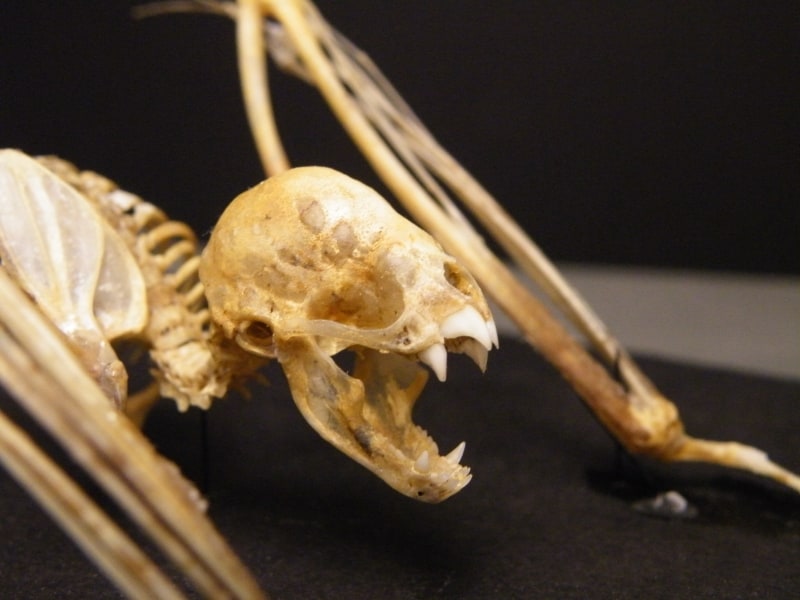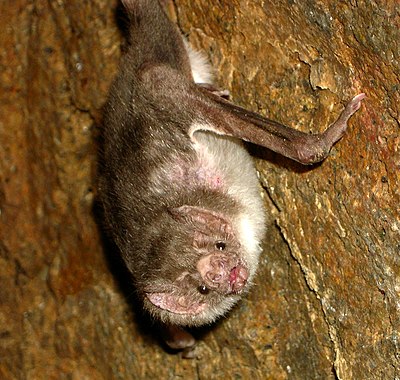Bats are often associated with vampires or Dracula and regarded as blood sucking creatures, becoming icons of horror and celebrations such as Halloween. But this association is almost completely unfounded. Almost.
Out of thousands of species of bats, there are indeed three species of bats that feed on blood. They are called the vampire bats and this is their story.

Desmodus
Bats are the only mammal capable of sustained flight, and they’ve fascinated humans since we first laid eyes on them. More recently, we’ve learned other remarkable bat facts, like them being able to use echolocation and having extremely powerful immune systems.
Bats are a surprisingly diverse group, despite their unique lifestyle. They can consume many food sources, including nectar, pollen, insects, fruit and meat — but only a small group of bats feeds on blood.
Worldwide, there are only three species of vampire bats:
- the Common Vampire Bat (Desmodus rotundus);
- the Hairy-legged Vampire Bat (Diphylla ecaudata);
- and the White-winged Vampire Bat (Diaemus youngi).
The Common Vampire Bat is the most frequently encountered one which has a wingspan of 35-40 cm (inches) and can weigh around 30-40 grams (pounds). Fossil records reveal that they lived as far as north as California and Virginia during the warmer geologic era. However, today their distribution is only restricted to Latin America, from northern Mexico to northern Argentina. They often rest inside caves, hollow trees, old wells and abandoned buildings.
In fact, they like to spend their time in completely dark environments. It’s understandable since their vision isn’t all that good, but they can orient themselves using echolocation. They’ve also got an infrared detector, just like snakes, that helps them to find hot animals they can feed on.
Desmodus
Vampire bats are hematophages just like mosquitos, fleas, and leeches — meaning they drink blood as a source of food.
Drinking blood is not that advantageous of a feeding strategy. Sure, blood can be nutritious, but it’s a liquid food, and therefore can overwhelm the kidneys. Blood consumption can also cause iron intoxication and a number of other problems the bats have had to learn to cope with.
The vampire bats’ preference for blood is the most extreme food specialization in bats — and it’s so surprising that researchers aren’t even sure how they evolved it. The fossil record shows that the vampire bat lineage diverged from its family 26 million years ago, and within 4 million years had already developed its unique taste for blood, which is an extremely rapid rate of adaptation for a mammal species.
However, that’s when myth starts diverging from reality once again. While these bats do feed on blood, they don’t have any preference for human blood. In fact, some species are so particular about what they eat that they flat-out reject anything that isn’t a goat or bird. Most often, vampire bats feed on domestic animals or other small creatures.
Bloodthirsty bats? Not exactly
Vampire bats only hunt in the dark. Their feeding adventure starts when the sun has set. Using their ultrasonic navigation, they venture out into the wild, using their poor eyesight and echolocation to avoid collisions during flight. Echolocation is the ability to bounce sound waves off objects so the returning sound waves provide information about food sources and potential danger. Bats use a different sound frequency for this.
But bats don’t only rely on echolocation, they also have a well-developed olfactory sense equipped with heat sensors enabling them to detect warm blood. After locking on to a (usually sleeping) target, a vampire bat lands on or near the potential food source and utilizes its strong hind legs and thumb to climb around its prey. Upon finding a perfect spot, it uses its razor-sharp incisors to make a painless cut in the skin.
Their teeth (the upper incisors) are incredibly sharp. They aren’t covered by enamel, which helps keep them razor sharp — so much so that even handling their skulls in a museum can result in cuts.

But after they make their incision, contrary to popular belief, vampire bats do not suck blood. Every night, they at least need to drink two tablespoons or 20 grams of blood, but rather than sucking like a tv vampire, they use their grooved tongue to lick on the blood from the cut. Their saliva contains an anticoagulant called draculin that encourages the blood to flow.
Research on the anticoagulant enzyme draculin has been initiated and its potential in dissolving blood clots and similar problems in human blood is currently being explored. If its efficacy is proven, this will be a vital advancement in helping to save the lives of stroke victims.
Social behavior
Vampire bats are very social and remarkably altruistic with other colony members, sometimes sharing blood with those who have not acquired food.
Because a vampire bat can only go around two days without eating, they can get desperate when they can’t find food. To overcome this, they “beg” other bats for food. Other bats that have had their fill can be inclined to help their peers and regurgitate small amounts of blood. They seem to form this type of relationship based on reciprocity: I’ll help you if you help me type of relationship, but they also seem to remember their friends and family. Altruism seems to pay off for these bats: individuals that spend their own energy helping others seem to be more likely to thrive, so altruistic behavior is incentivized in the colony.
When it comes to its pup, newborns feed primarily on the mother’s milk. At two months, pups are being fed by regurgitated blood until they become independent and able to look for their own prey.
Vampire bats, livestock, and humans

In Pre-Columbian times, these blood-eating bats existed only in small numbers. However, with the arrival of European colonists 400 years ago, came herds of cattle, horses, and other livestock. This provided vampire bats with an abundant and limitless supply of food allowing their populations to spike. Moreover, the increasing deforestation in Latin America has forced the bats to roost in or near human settlements,in which they have been regarded as serious agricultural pests.
While many of the risks people associated with vampire bats are simply myths, there is one problem that is very real: transmitting disease. For instance, they can transmit rabies, although this is very rare. Only 0.5% of bats carry rabies, and those that do may be clumsy, disoriented, and unable to fly — which makes them very unlikely to spread the disease, though the risk is not zero. There are typically around a couple dozen cases in South America per year.
Various methods have been used to control their populations, including burning out of caves and hollow trees, and shooting and poisoning them. These methods are problematic, however, as they are not selective for vampire bats and oftentimes harm other species of bats and other animals that share habitat. It is unfortunate that vampire bats through time have been regarded as pests. But when you try to dig up the problem, is it really them that are invading human space?
It is only through education and scientifically planned programs that this problem can be solved. Several techniques have been developed to control vampire bats without causing harm to other species. Cows can be injected with small amounts of drugs harmless to the cow, but fatal to the bats that ingest their blood. These new methods must be given more emphasis as to ensure a sustainable and effective approach to controlling their numbers.
Vampire bats are remarkable creatures. They’re essentially a type of parasite, but they show remarkable adaptation and resilience with their very special lifestyle. In fact, their adaptations are so remarkable that they can guide some medical research.
Under normal conditions, they’d pose no real risk to humans, but because of our reckless development (and in particular, livestock and deforestation), we’re crossing paths with them more and more. Hopefully, we can find ways to peacefully coexist with them and not become the monsters that wipe them out.



